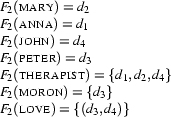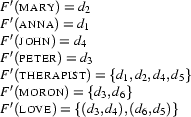1.1.4 Exact Models
Introduction of the concept of an exact model , having a name for each entity in the domain.
What is an Exact Model?
Here's a second model for our vocabulary. We'll use the same domain (that is,  ) but change the interpretation function. To emphasize that the interpretation function has been altered, we'll use a different symbol (namely
) but change the interpretation function. To emphasize that the interpretation function has been altered, we'll use a different symbol (namely  ) for it.
) for it.
Exercise 1.1
Give a (natural language) description of this model.
It's important to mention one special trait both of the models we have defined show: every entity in  exclusively corresponds to one constant. From now on, we will call any model with this specific an exact model .
exclusively corresponds to one constant. From now on, we will call any model with this specific an exact model .
An Inexact Model
While exact models are particularly easy to work with, it is vital to realize that by no means every model is an exact one. Just suppose we add two more entities to the domain of the first model; thus creating a new domain  , and furthermore define a new interpretation function
, and furthermore define a new interpretation function  on
on  as follows:
as follows:
This new model is similar to our second model, the difference being that it has two extra entities. Neither of these new entities has a name, but we can see that one of them is a therapist, while the other one is a moron, and that the unnamed moron loves the nameless therapist. This is still a perfectly good first-order model, for the following two reasons:
There is no requirement that every entity in the model must have a name (we only bother to name entities of special interest).
There is no requirement that each entity in a model must be named by exactly one constant.
For example, if we wanted to we could assign both the names John and Peter to the same entity (for example if we wished that entity to have a real name and a nickname).

